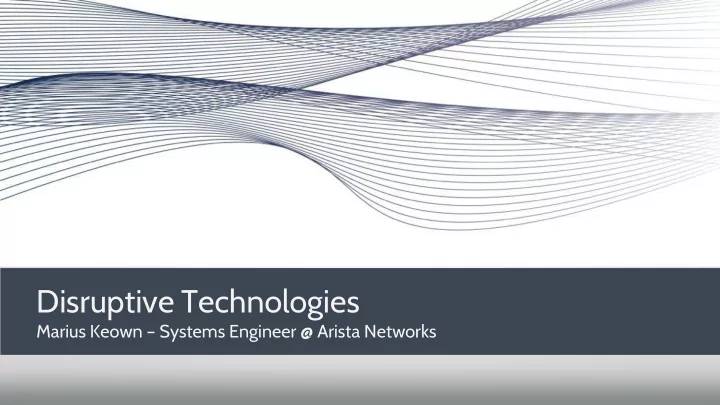

Disruptive Technologies Marius Keown – Systems Engineer @ Arista Networks
Moore’s Law - Dr Gordon E. Moore – Co-Founder of Intel - Predicted in 1965 the doubling of components per integrated circuit every year - In 1975 revised the forecast to doubling every 2 years - Used for decades as the guide for the industry for new products - Nothing like this in the history of mankind
Impact on Technology Industry - Economic Impact – Performance and Cost - Modern Computing
Moore’s Law and Networking
Three main problems Moore’s Law applies to Transistors, not Speed - - Transistor count is doubling every 2 years - Transistor speed is only increasing slowly - Number of I/O pins per package basically fixed - Limited by the area and package technology - Only improvement is increased I/O speed - Bandwidth ultimately limited by I/O capacity - Throughput per chip = # IO Pins x Speed/IO - No matter how many transistors are on-chip
SERDES Speed (high density CMOS)
Number of SERDES per Package
Maximum Throughput per Chip
Moore’s Law and Networking
Network Switching Industry Network ASIC performance has not increased CPUs 2X/2Y = 64X/12Y like CPU performance. Switching (Merchant Full Custom): 2X/2Y In a 12 year span: Performance Network ASIC increased: 10x • ASIC - LAN 1G to 10G 10X/12Y CPU perf has increased: 64x • ASIC - WAN Routers: 4X/12Y Investment vs. ROI • Time Low speeds, low port density, high power • consumption Why has Networking not kept up with Moore’s Law? • Long and slow development cycle • Inflexible to market changes ASIC = Application Specific Integrated Circuit Full Custom design flow • Top down design, independent of the layout • Bottom up approach, chip vendor focus on • Network Vendor focusing on the functionality not potential implementation • Chip design starts with the clock rate objective the implementation • ASIC supplier does the physical implementation • Data paths optimize to achieve the clock rates • Difficult to achieve high clock rates and scale • Only way to achieve high clock rates Only the Full custom Chip will allow us to scale for the future
Merchant Silicon 64-ports 10G Switch Chip
Port Density on Merchant Silicon - Broadcom Trident 2 - 128 x 10G - 32 x 40G - Broadcom Tomahawk - 32 x 100G - 128 x 25G - Broadcom Jericho - 6 x 100G, but with Big Buffers and large routing tables
Advantages of Merchant Silicon Custom Design vs. ASIC Design More ports per chip, increased • throughput More room for additional • logic/processing/functionality Less Chips: • Increased reliability, reduced • complexity ▪ Merchants’ full custom chips are Reduced latency (fewer chip crossing) • now on Moore’s Law growth rate Consume less power ( less chips less • ▪ ASIC designs are NOT on Moore’s power draw) Law growth
Merchant Silicon for SP
Hyper Connected World We are in an age of exponential growth 30B 25B 25B 20B 15B 10B 5B 5B 4B 1.8B 1.8B 800K 2010 2015 2020 Sources: Cisco ,Gartner, CMA Research, EdgeConneX 15
Over-the-Top Video Mobility SP Market Dynamics NFV Hyper Scale DC 1 6
Emerging SP Challenge and Opportunity
SP Networks Transformation Requirement • Urgent Network C/O-EX Optimization • Operational Efficiency Revenue • Improved Revenue Stream OBJECTIVE APPROACH • Sustainable OPEX compression • Reliable and Cost Optimized Hardware • NFV • Operational re-engineering CapEx • Operational Automation Programmable Network OpEx • Network Re-architecture • Re-Architect for the Least Common Denominator
Bringing Merchant Silicon to the WAN Edge WAN Edge (CE) routers represent highest CapEx investment in infrastructure today Challenges: Universal Cloud Many niche features • Network Full internet routing table in hardw are • Internet Inter-DC WAN DCI Public Transit Peerin Routing Capability → g Feature WAN Edge Complexity Merchant Silicon Spine capabilities Leaf Time →
Less Than Half the Power Consumption Merchant ASIC Silicon Vendors Typical Power Consumption (W) per 100G port Merchant ASIC ASIC ASIC ASIC ASIC ASIC Silicon Product A Product B Product C Product D Product E Product F • Half the power compared to closest competitor • >6X more power efficient than legacy
Merchant Silicon vs. Legacy Router Price Merchant ASIC Silicon Vendors Merchant ASIC ASIC ASIC ASIC ASIC ASIC ASIC Silicon Product A Product B Product C Product D Product E Product • Legacy Routing Platforms heavy on features, power, and price F Product G • Expect new Routing switch platforms to disrupt installed base
Merchant Silicon for SP Use Cases
1: DC CORE NEEDS A SPINE
2: Internet Peering – Evolution to Content Peering
3: Cloud and WAN Segment Routing
4: Telco Transformation - Service Provider NFV SP Service Edge Evolution Next Gen Telco NFV Cloud Software Strategy - Time to Market for Orchestration, Service SDN Controller new Services Increase instantiation Deep Buffer Universal Cloud Leaf-Spine Over The Top Traffic Architecture Network Leaf-Spine Increase Architecture Reliance on expensive Virtualize and Scale HW Service Edge Out Routers
Summary - Following M oore’s Law - Higher Port Density - Lower Price per Port - Lower Power Consumption
Thank You
Recommend
More recommend